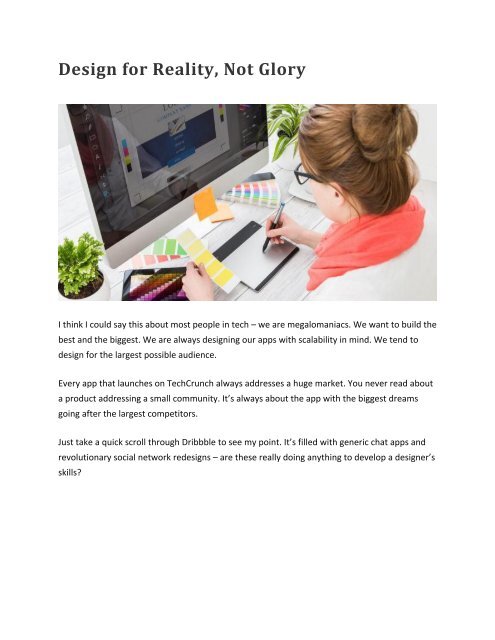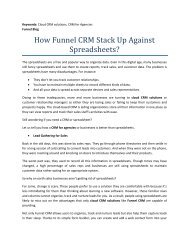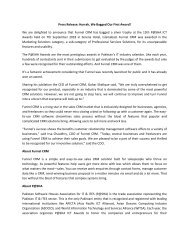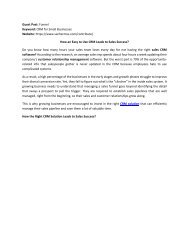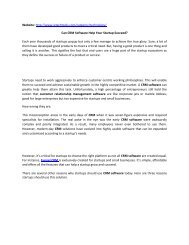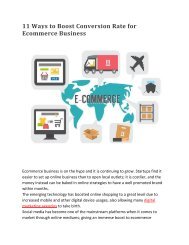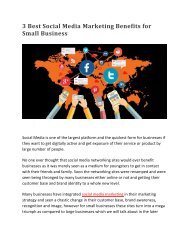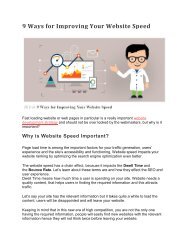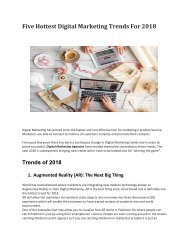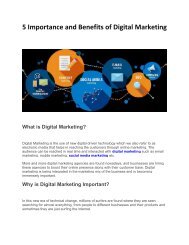Design for Reality
Designing for reality sounds great, but how do you get that first project? Read the challenge in the article
Designing for reality sounds great, but how do you get that first project? Read the challenge in the article
Create successful ePaper yourself
Turn your PDF publications into a flip-book with our unique Google optimized e-Paper software.
<strong>Design</strong> <strong>for</strong> <strong>Reality</strong>, Not Glory<br />
I think I could say this about most people in tech – we are megalomaniacs. We want to build the<br />
best and the biggest. We are always designing our apps with scalability in mind. We tend to<br />
design <strong>for</strong> the largest possible audience.<br />
Every app that launches on TechCrunch always addresses a huge market. You never read about<br />
a product addressing a small community. It’s always about the app with the biggest dreams<br />
going after the largest competitors.<br />
Just take a quick scroll through Dribbble to see my point. It’s filled with generic chat apps and<br />
revolutionary social network redesigns – are these really doing anything to develop a designer’s<br />
skills?
I believe that designers take on projects with such an ambitious scale as a result of our egos.<br />
What designers don’t realize though is that many of the world’s most well-known products<br />
didn’t start with global ambitions. Rather, they often addressed a small, local need first and<br />
grew from there. There<strong>for</strong>e, if you really want to develop your skills and produce a truly<br />
creative product, you will be much better off checking your ego and starting small.<br />
Stop Inflating Your Ego<br />
In the book “Ego is the Enemy,” Ryan Holiday uses past examples of famous figures – both<br />
successful and unsuccessful – to illustrate the adverse effects of the ego.<br />
While Holiday writes to all industries, not just design, designers will learn a lot from him.
His book addresses the type of thinking that distracts us from designing a product <strong>for</strong> a small<br />
audience, which helps you and another five people instead of 100 million faceless people who<br />
you don’t know personally.<br />
<strong>Design</strong>ing with your ego creates a product that is diluted, unfocused, and just bland. Consider<br />
these well-known products that didn’t give into big thinking in the beginning.<br />
<br />
<br />
<br />
Facebook was designed first <strong>for</strong> people at Harvard, not <strong>for</strong> a billion people around the world. If<br />
Mark Zuckerberg designed Facebook <strong>for</strong> a billion people on day one, it would have failed.<br />
Facebook was online <strong>for</strong> two years be<strong>for</strong>e opening itself up to the general public.<br />
Uber was originally a black car service in San Francisco. Today, Uber has evolved from a local<br />
black car service, to a global ridesharing app, and now, to a service <strong>for</strong> lifestyle and logistics. In<br />
2008, this wouldn’t have meant anything to anyone.<br />
Flickr began as a photo-sharing feature within an online game. Only after the product had been<br />
perfected did the team realize that it could be applied more broadly. In 2005, Flickr was<br />
acquired by Yahoo. Today, it has 51 million registered users worldwide.<br />
“Ego is the enemy of what you want and of what you have: Of mastering a craft. Of real creative<br />
insight. Of working well with others. Of building loyalty and support. Of longevity. Of repeating<br />
and retaining your success. It repulses advantages and opportunities. It’s a magnet <strong>for</strong> enemies<br />
and errors. It is Scylla and Charybdis.”― Ryan Holiday, Ego Is the Enemy<br />
Get Out of Your Head!<br />
<strong>Design</strong>ers all have a tendency to turn their life into a story. We write a fantastic narrative of our<br />
past with ourselves at the center – I helped design billion dollar companies or I worked <strong>for</strong><br />
[insert massive startup here] – and this distracts us from designing <strong>for</strong> reality.<br />
We often produce concept work to develop or show off our abilities as designers.<br />
What I’m suggesting is to not let your ego guide you toward producing a concept <strong>for</strong> another<br />
billion-dollar startup. These companies became the way they are over long periods of<br />
refinement and being patient. There<strong>for</strong>e we can only possibly provide an undeveloped opinion<br />
on redesigning their product.
The only reason that we might strive to design <strong>for</strong> the best brands is to fulfill our own career<br />
narratives.<br />
As designers, we need to get out of our head and look instead to immediate local problems that<br />
call <strong>for</strong> unique design solutions. Not only will this direct our abilities toward solving real<br />
problems, but it will also make us better designers while we’re at it.<br />
There are often many lessons and opportunities surrounding us. However, if we’re caught up in<br />
the grandiose vision of our careers, these lessons will appear small or inconsequential, and we<br />
may miss them.<br />
If you think that taking on a small project is demeaning to the potential scale of your work, get<br />
out of your head. Keep in mind that there is no one to per<strong>for</strong>m <strong>for</strong>. And quite frankly, much less<br />
people are keeping tabs on your career than you may think. In fact, it’s likely that no one is. This<br />
can be hard to digest when you’re stuck inside your own head.<br />
Don’t Linger on Past Successes<br />
When we reminisce about our past successes, we <strong>for</strong>get about the hours of work and execution<br />
that got us to where we are today. So instead of dreaming about your story, get back to work<br />
and out of your head. Start a new page daily, and eliminate any ideas of grandeur.<br />
“I was trapped so terribly inside my own head that I was a prisoner to my own thoughts.” –<br />
Ryan Holliday<br />
Be a Student<br />
In order <strong>for</strong> your design work to grow, you must be able to learn from criticism. Participating in<br />
the dialogue of design communities, such as Dribbble, is valuable, but they can also shelter your<br />
work from the lessons of reality.<br />
The online design community is extremely supportive to one another. It’s great that everyone<br />
can so easily join such a conversation. However, constantly looking <strong>for</strong> positive feedback will<br />
not drive us to learn, so we must be careful in how eagerly we participate.
When you design <strong>for</strong> reality, clients and the public will be very hard on your work.<br />
Although it can be difficult to hear negative feedback, we must see this as an opportunity to<br />
learn. The designer who works <strong>for</strong> their ego will be defensive during these times and will likely<br />
reject the opinion of the offender. We must learn to accept such criticisms if we want our work<br />
to grow.<br />
The feedback loop between the designer and the client can make products that neither party<br />
could have ever made on their own.<br />
As designers, we must realize that we can learn from the needs and conditions of a real project<br />
in order to make something new. Whereas, the feedback loop online often recycles the same<br />
content over and over again.<br />
Like what you’re reading?<br />
Get the latest updates first.<br />
No spam. Just great design posts.<br />
Thinking Small and Local<br />
In reading this, you might be wondering where to start. <strong>Design</strong>ing <strong>for</strong> reality sounds great, but<br />
how do I get that first project? Or, if work is slow, what can I do to continue to grow?<br />
This is very much my point – that often the answer to this is to whip up some great redesigns,<br />
and post them online in the hope that they’ll lead to the next big thing. But, how can you direct<br />
your energy to designing <strong>for</strong> real life instead?<br />
Consider the challenge below.<br />
<strong>Design</strong> <strong>for</strong> The Very Small
Instead of designing the next billion dollar chat app, what if you designed a chat app <strong>for</strong> five<br />
moms? What would that look like? Do you think something original would come out of it if you<br />
just focused on them?<br />
<br />
<br />
<br />
<br />
<br />
<br />
What would your social network look like if it was designed <strong>for</strong> the people in your building?<br />
What would a payment service app look like <strong>for</strong> a farmer’s market?<br />
How might a calendar registry app work <strong>for</strong> a day care?<br />
Would a restaurant use a better interface <strong>for</strong> how they seat customers?<br />
Could high school teachers benefit from an app to communicate with parents?<br />
How might a to-do list work <strong>for</strong> a small family?<br />
Let’s face it, it’s all about our ego. We design to get recognition instead of designing to solve a<br />
real problem <strong>for</strong> a small group of people.<br />
I would argue that only designing <strong>for</strong> a successful Dribbble shot is thinking too small. It satisfies<br />
our ego, but won’t get us anywhere. Would you have taken Facebook as a client when they<br />
were only addressing Harvard?<br />
Focus Your <strong>Design</strong><br />
Gather five people in a niche and start designing a product just <strong>for</strong> them.<br />
Don’t listen to your ego encouraging you to get likes and recognition. Focus on making the best<br />
possible product <strong>for</strong> those five people.<br />
Here’s six points you should focus on.<br />
1. Involve real users in your designs as soon as possible.<br />
2. Solicit feedback, and consider how your product can improve.<br />
3. Don’t worry about scalability.<br />
4. Kill aesthetics. Yes the aesthetic side of the design feeds our ego. The first focus should be<br />
getting a few users.<br />
5. Avoid feature creep. Local problems can be complex too, but try to keep your solution simple.<br />
6. Make sure your ego doesn’t creep up on you. Every time you start to really love something you<br />
worked on you should be wary. Your ego must be hiding behind your love.<br />
Let’s Work to Kill Our Egos
Whatever is next <strong>for</strong> us – failure or success – we must always continue to remember to avoid<br />
our egos.<br />
No matter what awaits us down the road, our egos will make everything more difficult.<br />
However, failure is the one thing that our egos will help to make permanent, unless we are<br />
willing to be students as we move <strong>for</strong>ward, and learn from our mistakes.<br />
We must take every moment as an opportunity to grow, not boost our careers.<br />
Every great designer has experienced difficult times. You may just not realize it because all you<br />
see is their polished Dribbble accounts. What they likely aren’t telling you is that when they<br />
have failed – or found hardship – they take some kind of benefit from it.<br />
Finally, keep in mind that many of the most successful people do not spread their work and<br />
successes around. So, look <strong>for</strong> people in your design community who are quiet about their<br />
success, or failure, and see what you can learn from them.<br />
Published on: https://www.buzzinteractive.co/design-<strong>for</strong>-reality-not-glory/


